 Relevant History welcomes Sheila York who, after a successful career in TV and radio, began writing novels combining her love of mystery, history and the movies. Her series features screenwriter Lauren Atwill (and her lover, private detective Peter Winslow) chasing killers in the last hurrah of the Great Golden Age of Film. Sheila’s first novel, Star Struck Dead, won a Daphne du Maurier award. Lauren’s latest adventure, No Broken Hearts, was praised by Charles Todd: “If you love a terrific mystery, York is a must read!” To learn more about her and her books, visit her web site, and follow her on Facebook and Twitter.
Relevant History welcomes Sheila York who, after a successful career in TV and radio, began writing novels combining her love of mystery, history and the movies. Her series features screenwriter Lauren Atwill (and her lover, private detective Peter Winslow) chasing killers in the last hurrah of the Great Golden Age of Film. Sheila’s first novel, Star Struck Dead, won a Daphne du Maurier award. Lauren’s latest adventure, No Broken Hearts, was praised by Charles Todd: “If you love a terrific mystery, York is a must read!” To learn more about her and her books, visit her web site, and follow her on Facebook and Twitter.
*****
Censorship has a long, complicated history in America. Don’t worry, I’m going to spare you that.
Instead, we’re going on a short, high-points tour of the censorship of American film. Ah, maybe you didn’t know movies were once heavily censored. You thought in all those Golden Age films when passion overcame lovers, they just naturally pressed their cheeks together and faced the camera rather than locking lips. And never noticed the lack of cleavage and that nobody got away with a crime.
There were, you see, rules. They were called the Production Code, and they controlled the content of American films from 1934 until replaced with an early form of our ratings system in the late 1960s (following years of rebellion by filmmakers and audiences).
OK, here’s our first stop: the very first line of the Production Code.
No picture shall be produced which will lower the moral standards of those who see it.
Wow. You’ve got to wonder what led to that.
The power of silents
The impact of silent films is hard to imagine today, in an age of instant communication, but they were our first shared national cultural experience. Across the country audiences thrilled to the same movies with the same stars, and devoured the same fan magazines (a new sensation) awash in stories about them. American film stars were the most famous people in the world – Fairbanks, Swanson, Chaplin, Pickford, Keaton, Valentino.
However, silent films had no rules, and pretty quickly communities and religious groups worried about movies’ influence, and what some filmmakers were up to: flouting conventional morality, ridiculing authority, reveling in sexual innuendo, and joking about drunkenness and drugs.
By 1921, five states—Pennsylvania, Ohio, Maryland, Kansas, and New York—had established censorship boards. With nearly 30% of America’s ticket sales, they had the muscle to ban individual films in their states or delete scenes they deemed inappropriate. Some cities followed suit. After traveling through a few towns, a film could be rendered incomprehensible.
Some citizens thought the federal government should control films.
We can police ourselves. Yeah, sure.
In 1922, the major studios formed the Motion Picture Producers and Distributors of America and picked Will Hays, a man well connected in Washington, to run it. The best the MPPDA could do was create a long list of content guidelines, “The Don’ts and the Be Carefuls”. Compliance was voluntary.
The sound and more fury
 In the late 1920s, films began to speak; reformers could be shocked by what they saw and heard. And they saw and heard plenty. When the Depression cut into box office, studios discovered sex and violence could sell tickets. Tommy-gun-toting gangsters ruled in films like Little Caesar. Mae West brought her shocking double-entendres to Hollywood.
In the late 1920s, films began to speak; reformers could be shocked by what they saw and heard. And they saw and heard plenty. When the Depression cut into box office, studios discovered sex and violence could sell tickets. Tommy-gun-toting gangsters ruled in films like Little Caesar. Mae West brought her shocking double-entendres to Hollywood.
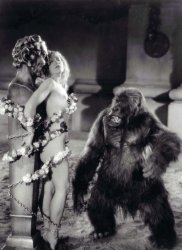 And Mr. DeMille made a movie called—I’m not kidding—The Sign of the Cross. Orgies, Christians sacrificed, Claudette Colbert bathing naked. The theory seems to have been that this would demonstrate Roman degeneracy.
And Mr. DeMille made a movie called—I’m not kidding—The Sign of the Cross. Orgies, Christians sacrificed, Claudette Colbert bathing naked. The theory seems to have been that this would demonstrate Roman degeneracy.
Maybe Mr. De Mille just couldn’t control himself.
Hey, what about a Code? It was already there.
The Code was written in 1929 by a priest named Daniel Lord and Martin Quigley, a movie-industry-publication owner (and devout Catholic). Quigley (and many others) lobbied for its adoption. Studio heads agreed, but the administration they created in 1930 had only the power of persuasion.
In response, the Catholic Church developed its own ratings system. Then came their Legion of Decency. Its pledge’s first line gives you some idea of how the Church felt: I wish to join the Legion of Decency, which condemns vile and unwholesome moving pictures.
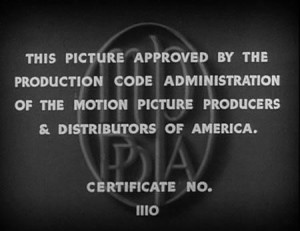 Finally the MPPDA ceded full power to control content. Beginning 1 July 1934, films could not be distributed without the Code seal of approval. The Code finally had teeth. Joe Breen, a public relations man and movie lover with excellent Church connections, ruled the Code Office for the next twenty years.
Finally the MPPDA ceded full power to control content. Beginning 1 July 1934, films could not be distributed without the Code seal of approval. The Code finally had teeth. Joe Breen, a public relations man and movie lover with excellent Church connections, ruled the Code Office for the next twenty years.
His office screened books/plays whose rights the studios were considering purchasing. Studios submitted draft scripts for early advice. While filmmakers could negotiate (and the Code Office would sometimes change its mind), they had to get approval of their shooting scripts and the final cuts of their films.
So this, briefly, is how we ended up with movies striving not to lower moral standards, in which adultery could never be justified and marriage was sacred. No nudity or suggestive costumes. No excessive kissing or drinking. Justice must triumph.
Here are a few of my favorites from the 1940s, the decade in which my heroine must grapple with the Code, with some Code notes you might enjoy.
The Best Years of Our Lives (46): The Code Office wanted all drinking eliminated. Try handling that when your script has a crucial bar-hopping scene.
The Big Sleep (46): Notice how much sexual innuendo they get away with in the bookstore.
The Blue Dahlia (46): In the original script, the wounded ex-Navy flyer (William Bendix) was the killer. Shown the script, the Navy objected. The movie got a new killer.
Casablanca (42): The censors forbade any overt indication that Captain Renault exchanged visas for sex; notice Strasser must draw his gun before Bogart can fire.
Crossfire (47): The murder victim in its source novel, The Brick Foxhole, was homosexual. Breen called it “completely unacceptable.” The victim became Jewish. The writer made sure to give him a girlfriend.
Double Indemnity (44): The poignant ending was made possible because the Code Office forbade any portrayal of an execution in early notes.
The Lady Eve (41): Check out Stanwyck/Fonda nuzzling in her stateroom. Pretty hot, but notice she’s on a chaise and he’s on the floor.
The Maltese Falcon (41): The Code Office forbade the suggestion of Spade’s affair with his partner’s wife (though it’s still crystal clear).
Notorious (46): It’s amazing this movie ever got made: a woman of loose morals as the heroine? Screenwriter Ben Hecht is my hero.
Rebecca (40): No one can get away with murder. The book’s resolution changed.
*****
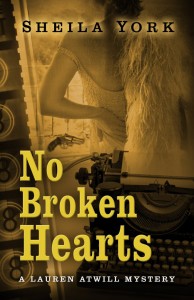 A big thanks to Sheila York. She’ll give away hardback copy of No Broken Hearts to someone who contributes a comment on my blog this week. I’ll choose the winner from among those who comment by Friday at 6 p.m. ET. Delivery is available in the U.S. only.
A big thanks to Sheila York. She’ll give away hardback copy of No Broken Hearts to someone who contributes a comment on my blog this week. I’ll choose the winner from among those who comment by Friday at 6 p.m. ET. Delivery is available in the U.S. only.
**********
Did you like what you read? Learn about downloads, discounts, and special offers from Relevant History authors and Suzanne Adair. Subscribe to Suzanne’s free newsletter.

 Relevant History welcomes M. Ruth Myers, who received a Shamus Award from the Private Eye Writers of America for Don’t Dare a Dame, the third book in her Maggie Sullivan mystery series. The series follows a woman private investigator in Dayton, Ohio, from the end of the Great Depression through the end of WW2. Other novels by the author, in various genres, have been translated, optioned for film, and condensed for magazine publication. She earned a Bachelor of Journalism degree from the University of Missouri J-School and worked on daily papers in Wyoming, Michigan and Ohio. To learn more about Ruth and her books, visit her
Relevant History welcomes M. Ruth Myers, who received a Shamus Award from the Private Eye Writers of America for Don’t Dare a Dame, the third book in her Maggie Sullivan mystery series. The series follows a woman private investigator in Dayton, Ohio, from the end of the Great Depression through the end of WW2. Other novels by the author, in various genres, have been translated, optioned for film, and condensed for magazine publication. She earned a Bachelor of Journalism degree from the University of Missouri J-School and worked on daily papers in Wyoming, Michigan and Ohio. To learn more about Ruth and her books, visit her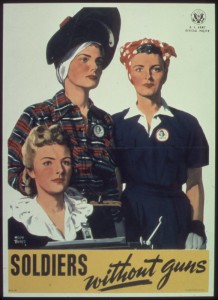 Housing was just one of the hardships faced by women whose husbands flooded into the military. If they wanted to live with their husband while he was in training, they’d find themselves sharing an apartment with another couple, or living in a lean-to, possibly with no bathtub. Nor were they always welcomed by locals. Two teachers from Missouri recall being called “low-down soldiers’ wives” and “damn Yankees” when they went to see their husbands at Ft. Knox, KY. The “rooms” they managed to find consisted of cots in the hall of rooming houses. When their husbands shipped out, women knew they wouldn’t see them again until the war ended—or they came home too badly wounded for further service. Because the military censored letters from men in uniform, the women at home didn’t even know the country where they were stationed.
Housing was just one of the hardships faced by women whose husbands flooded into the military. If they wanted to live with their husband while he was in training, they’d find themselves sharing an apartment with another couple, or living in a lean-to, possibly with no bathtub. Nor were they always welcomed by locals. Two teachers from Missouri recall being called “low-down soldiers’ wives” and “damn Yankees” when they went to see their husbands at Ft. Knox, KY. The “rooms” they managed to find consisted of cots in the hall of rooming houses. When their husbands shipped out, women knew they wouldn’t see them again until the war ended—or they came home too badly wounded for further service. Because the military censored letters from men in uniform, the women at home didn’t even know the country where they were stationed.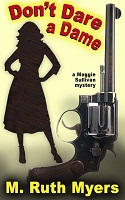 A big thanks to M. Ruth Myers. No Game for a Dame (Maggie Sullivan #1) is available free for
A big thanks to M. Ruth Myers. No Game for a Dame (Maggie Sullivan #1) is available free for  Relevant History welcomes Susan Higginbotham, a prize-winning author who has published historical fiction and biography. Her latest historical novel, Hanging Mary, her first to be set in the United States, is narrated by Mary Surratt and her young boarder, Nora Fitzpatrick. To learn more about Susan and her books, visit her
Relevant History welcomes Susan Higginbotham, a prize-winning author who has published historical fiction and biography. Her latest historical novel, Hanging Mary, her first to be set in the United States, is narrated by Mary Surratt and her young boarder, Nora Fitzpatrick. To learn more about Susan and her books, visit her  In March, Sarah once again made the hazardous trip North, this time staying overnight at the Surratt boardinghouse, much to the interest of Mary’s boarder Louis Weichmann, who gave up his bedroom for the veiled lady. General Edwin Gray Lee, a Confederate agent based in Montreal, wrote on 22 March that he had “helped . . . to get the messenger off. I pray she may go safely.” On 25 March, Sarah arrived once again at the Surratt boardinghouse. This time, Mary and John Surratt traveled with her to Maryland, where they were met by the distressing news that Howell, who had been assigned to take Sarah across the Potomac and then to Richmond, had been arrested. John Surratt took it upon himself to take Sarah to Richmond, where they remained until 1 April. Two days later, they arrived in Washington, to be greeted with the news that Richmond had fallen to the Union. The next morning, 4 April, they went North again. It was Sarah’s last mission for the Confederacy.
In March, Sarah once again made the hazardous trip North, this time staying overnight at the Surratt boardinghouse, much to the interest of Mary’s boarder Louis Weichmann, who gave up his bedroom for the veiled lady. General Edwin Gray Lee, a Confederate agent based in Montreal, wrote on 22 March that he had “helped . . . to get the messenger off. I pray she may go safely.” On 25 March, Sarah arrived once again at the Surratt boardinghouse. This time, Mary and John Surratt traveled with her to Maryland, where they were met by the distressing news that Howell, who had been assigned to take Sarah across the Potomac and then to Richmond, had been arrested. John Surratt took it upon himself to take Sarah to Richmond, where they remained until 1 April. Two days later, they arrived in Washington, to be greeted with the news that Richmond had fallen to the Union. The next morning, 4 April, they went North again. It was Sarah’s last mission for the Confederacy.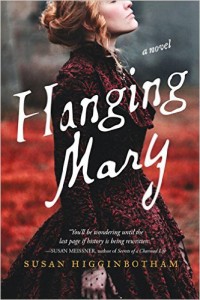 A big thanks to Susan Higginbotham. She’ll give away a paperback copy of Hanging Mary to someone who contributes a comment on my blog this week. I’ll choose the winner from among those who comment by Friday at 6 p.m. ET. Delivery is available in the U.S. only.
A big thanks to Susan Higginbotham. She’ll give away a paperback copy of Hanging Mary to someone who contributes a comment on my blog this week. I’ll choose the winner from among those who comment by Friday at 6 p.m. ET. Delivery is available in the U.S. only.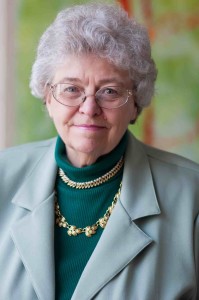 Relevant History welcomes former magazine editor and freelance writer Carolyn Mulford, who worked on five continents before making the transition to fiction. Thunder Beneath My Feet is her second middle grade/young adult historical novel. The Missouri Center for the Book selected the first, The Feedsack Dress, as the state’s Great Read at the 2009 National Book Festival. Show Me the Ashes, the fourth in her award-winning contemporary mystery series for adults, will be released in hardback and ebook on 16 March. To learn more about her and her books, visit her
Relevant History welcomes former magazine editor and freelance writer Carolyn Mulford, who worked on five continents before making the transition to fiction. Thunder Beneath My Feet is her second middle grade/young adult historical novel. The Missouri Center for the Book selected the first, The Feedsack Dress, as the state’s Great Read at the 2009 National Book Festival. Show Me the Ashes, the fourth in her award-winning contemporary mystery series for adults, will be released in hardback and ebook on 16 March. To learn more about her and her books, visit her 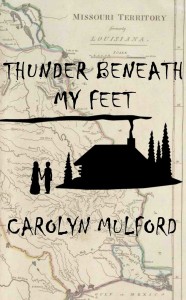 A big thanks to Carolyn Mulford. She’ll give away a paperback copy of Thunder Beneath My Feet to someone who contributes a comment on my blog this week. I’ll choose the winner from among those who comment by Friday at 6 p.m. ET. Delivery is available in the U.S. only.
A big thanks to Carolyn Mulford. She’ll give away a paperback copy of Thunder Beneath My Feet to someone who contributes a comment on my blog this week. I’ll choose the winner from among those who comment by Friday at 6 p.m. ET. Delivery is available in the U.S. only. Relevant History welcomes Judith Starkson, who writes historical fiction and mysteries set in Troy and the Hittite Empire. Her debut, Hand of Fire, set within the Trojan War, combines history and legend in the untold story of Achilles’ captive Briseis. Hand of Fire was a semi-finalist in the prestigious M.M. Bennett’s Award for Historical Fiction. Starkston’s upcoming mystery series features Queen Puduhepa of the Hittites and won the San Diego State University Conference Choice Award. Puduhepa signed the first surviving peace treaty in history with Pharaoh Ramesses II; now she’s a sleuth. Ms. Starkston is a classicist (B.A. UC, Santa Cruz, M.A. Cornell). For more information, visit her
Relevant History welcomes Judith Starkson, who writes historical fiction and mysteries set in Troy and the Hittite Empire. Her debut, Hand of Fire, set within the Trojan War, combines history and legend in the untold story of Achilles’ captive Briseis. Hand of Fire was a semi-finalist in the prestigious M.M. Bennett’s Award for Historical Fiction. Starkston’s upcoming mystery series features Queen Puduhepa of the Hittites and won the San Diego State University Conference Choice Award. Puduhepa signed the first surviving peace treaty in history with Pharaoh Ramesses II; now she’s a sleuth. Ms. Starkston is a classicist (B.A. UC, Santa Cruz, M.A. Cornell). For more information, visit her 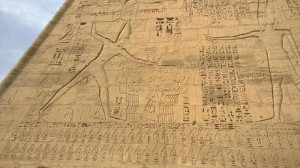 [Ramesses smiting the Hittites, Ramesseum, Photo by Morgana] In Egypt following the Battle of Kadesh in 1274 BCE, Pharaoh Ramesses ordered a version of this battle carved onto walls of his Ramesseum, his memorial temple to himself (as well as some other buildings—repetition was a virtue in his propaganda efforts). The Pharaoh, giant-sized, is shown crushing the very tiny Hittites single-handedly with his scepter. You would assume from this grand and heroic scene that Ramesses had retaken all the disputed lands in Syria from the Hittites, that he was the undisputed victor. Pharaohs get to tell history their way in their own land. Who’s going to argue with a god who rules the land with absolute authority? (More or less, putting aside those pesky uppity priests and internecine family squabbles, etc.)
[Ramesses smiting the Hittites, Ramesseum, Photo by Morgana] In Egypt following the Battle of Kadesh in 1274 BCE, Pharaoh Ramesses ordered a version of this battle carved onto walls of his Ramesseum, his memorial temple to himself (as well as some other buildings—repetition was a virtue in his propaganda efforts). The Pharaoh, giant-sized, is shown crushing the very tiny Hittites single-handedly with his scepter. You would assume from this grand and heroic scene that Ramesses had retaken all the disputed lands in Syria from the Hittites, that he was the undisputed victor. Pharaohs get to tell history their way in their own land. Who’s going to argue with a god who rules the land with absolute authority? (More or less, putting aside those pesky uppity priests and internecine family squabbles, etc.)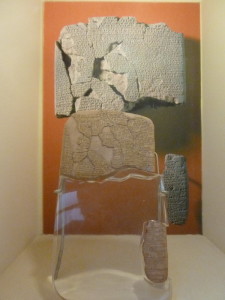 [Treaty of Kadesh between Ramesses and Hattusili/Puduhepa]It was a war whose large scale had done permanent damage to both sides, and these two sides eventually signed the first extant peace treaty in history, which you can see in the Istanbul Archaeological Museum. By that time, younger brother Hattusili was Great King and his indomitable wife, Puduhepa, also placed her seal on this treaty. Queens got a lot of respect among the Hittites, not at all like most of their ancient contemporaries.
[Treaty of Kadesh between Ramesses and Hattusili/Puduhepa]It was a war whose large scale had done permanent damage to both sides, and these two sides eventually signed the first extant peace treaty in history, which you can see in the Istanbul Archaeological Museum. By that time, younger brother Hattusili was Great King and his indomitable wife, Puduhepa, also placed her seal on this treaty. Queens got a lot of respect among the Hittites, not at all like most of their ancient contemporaries.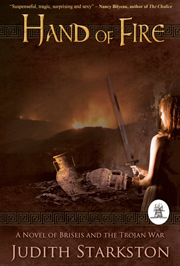 A big thanks to Judith Starkson. She’ll give away a paperback copy of Hand of Fire to someone who contributes a comment on my blog this week. I’ll choose the winner from among those who comment by Friday at 6 p.m. ET. Delivery is available in the U.S. only.
A big thanks to Judith Starkson. She’ll give away a paperback copy of Hand of Fire to someone who contributes a comment on my blog this week. I’ll choose the winner from among those who comment by Friday at 6 p.m. ET. Delivery is available in the U.S. only. Relevant History welcomes Sheila York who, after a successful career in TV and radio, began writing novels combining her love of mystery, history and the movies. Her series features screenwriter Lauren Atwill (and her lover, private detective Peter Winslow) chasing killers in the last hurrah of the Great Golden Age of Film. Sheila’s first novel, Star Struck Dead, won a Daphne du Maurier award. Lauren’s latest adventure, No Broken Hearts, was praised by Charles Todd: “If you love a terrific mystery, York is a must read!” To learn more about her and her books, visit her
Relevant History welcomes Sheila York who, after a successful career in TV and radio, began writing novels combining her love of mystery, history and the movies. Her series features screenwriter Lauren Atwill (and her lover, private detective Peter Winslow) chasing killers in the last hurrah of the Great Golden Age of Film. Sheila’s first novel, Star Struck Dead, won a Daphne du Maurier award. Lauren’s latest adventure, No Broken Hearts, was praised by Charles Todd: “If you love a terrific mystery, York is a must read!” To learn more about her and her books, visit her  In the late 1920s, films began to speak; reformers could be shocked by what they saw and heard. And they saw and heard plenty. When the Depression cut into box office, studios discovered sex and violence could sell tickets. Tommy-gun-toting gangsters ruled in films like Little Caesar. Mae West brought her shocking double-entendres to Hollywood.
In the late 1920s, films began to speak; reformers could be shocked by what they saw and heard. And they saw and heard plenty. When the Depression cut into box office, studios discovered sex and violence could sell tickets. Tommy-gun-toting gangsters ruled in films like Little Caesar. Mae West brought her shocking double-entendres to Hollywood. And Mr. DeMille made a movie called—I’m not kidding—The Sign of the Cross. Orgies, Christians sacrificed, Claudette Colbert bathing naked. The theory seems to have been that this would demonstrate Roman degeneracy.
And Mr. DeMille made a movie called—I’m not kidding—The Sign of the Cross. Orgies, Christians sacrificed, Claudette Colbert bathing naked. The theory seems to have been that this would demonstrate Roman degeneracy. Finally the MPPDA ceded full power to control content. Beginning 1 July 1934, films could not be distributed without the Code seal of approval. The Code finally had teeth. Joe Breen, a public relations man and movie lover with excellent Church connections, ruled the Code Office for the next twenty years.
Finally the MPPDA ceded full power to control content. Beginning 1 July 1934, films could not be distributed without the Code seal of approval. The Code finally had teeth. Joe Breen, a public relations man and movie lover with excellent Church connections, ruled the Code Office for the next twenty years. A big thanks to Sheila York. She’ll give away hardback copy of No Broken Hearts to someone who contributes a comment on my blog this week. I’ll choose the winner from among those who comment by Friday at 6 p.m. ET. Delivery is available in the U.S. only.
A big thanks to Sheila York. She’ll give away hardback copy of No Broken Hearts to someone who contributes a comment on my blog this week. I’ll choose the winner from among those who comment by Friday at 6 p.m. ET. Delivery is available in the U.S. only. Relevant History welcomes back Anna Castle, who writes the Francis Bacon mysteries and the Lost Hat, Texas mysteries. She’s earned a series of degrees—BA Classics, MS Computer Science, and PhD Linguistics—and has had a corresponding series of careers—waitressing, software engineering, assistant professor, and archivist. Writing fiction combines her lifelong love of stories and learning. To learn more about her and her books, visit her
Relevant History welcomes back Anna Castle, who writes the Francis Bacon mysteries and the Lost Hat, Texas mysteries. She’s earned a series of degrees—BA Classics, MS Computer Science, and PhD Linguistics—and has had a corresponding series of careers—waitressing, software engineering, assistant professor, and archivist. Writing fiction combines her lifelong love of stories and learning. To learn more about her and her books, visit her 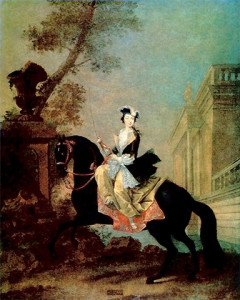 Most barristers would have ridden their own horses with their own handmade saddles and a servant or two to carry their packs and keep them company. Women traveled on horseback as well. They could choose to ride astride or sidesaddle. The sidesaddle was improved by Catherine de Medici in the sixteenth century, making it easier for women to control their mounts and thus ride independently.
Most barristers would have ridden their own horses with their own handmade saddles and a servant or two to carry their packs and keep them company. Women traveled on horseback as well. They could choose to ride astride or sidesaddle. The sidesaddle was improved by Catherine de Medici in the sixteenth century, making it easier for women to control their mounts and thus ride independently.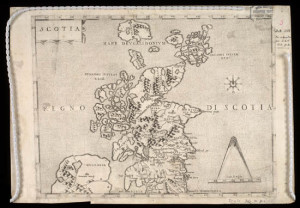 There were maps aplenty in those days—map-making was a booming craft—but they weren’t meant to aid travelers on land. Maps of coastlines, made by sailors, were amazingly good, but interior spaces were not often well represented. The Tudors were just beginning to get England’s roads organized into some kind of system. This map gives you an overall sense of Scotland’s topography, but it won’t get you from Glasgow to Edinburgh.
There were maps aplenty in those days—map-making was a booming craft—but they weren’t meant to aid travelers on land. Maps of coastlines, made by sailors, were amazingly good, but interior spaces were not often well represented. The Tudors were just beginning to get England’s roads organized into some kind of system. This map gives you an overall sense of Scotland’s topography, but it won’t get you from Glasgow to Edinburgh.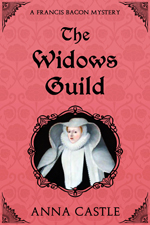 A big thanks to Anna Castle. She’ll give away an ebook or autographed paperback copy of The Widows Guild, her third Francis bacon mystery, to someone who contributes a comment on my blog this week. I’ll choose the winner from among those who comment by Friday at 6 p.m. ET. Delivery is available worldwide for the ebook and the U.S. only for the paperback.
A big thanks to Anna Castle. She’ll give away an ebook or autographed paperback copy of The Widows Guild, her third Francis bacon mystery, to someone who contributes a comment on my blog this week. I’ll choose the winner from among those who comment by Friday at 6 p.m. ET. Delivery is available worldwide for the ebook and the U.S. only for the paperback.